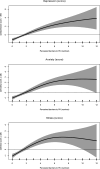Are perceived barriers to physical activity related to depression, anxiety and stress among adolescents? The EHDLA study
- PMID: 39314518
- PMCID: PMC11418574
- DOI: 10.1136/bmjsem-2024-002069
Are perceived barriers to physical activity related to depression, anxiety and stress among adolescents? The EHDLA study
Abstract
Objective: The aim of this study was twofold: first, to examine the association between perceived barriers to physical activity (PA) practice and depression, anxiety and stress in a sample of Spanish adolescents; and second, to determine which barriers are specifically associated with depression, anxiety and stress.
Methods: This cross-sectional study was conducted with 765 adolescents aged 12-17 (55.6% girls) in the Valle of Ricote, Murcia, Spain. Depression, anxiety and stress symptoms were assessed using the Depression, Anxiety and Stress Scale (DASS-21), with validated cut points employed to determine the presence of each of these mental conditions. The perception of barriers to PA was assessed using a validated questionnaire for the Spanish adolescent population.
Results: The barrier 'Because I feel that my physical appearance is worse than that of others' was related to a higher likelihood of having depression (OR=2.41; 95% CI 1.35 to 4.28; p=0.003), anxiety (OR=2.65; 95% CI 1.51 to 4.71; p=0.001) and stress (OR=2.82; 95% CI 1.59 to 5.07; p<0.001). Similarly, the barrier 'Because nobody encourages me to engage in physical activity' was related to a higher likelihood of having depression (OR=1.92; 95% CI 1.08 to 3.43; p=0.026), anxiety (OR=1.97; 95% CI 1.11 to 3.50; p=0.021) and stress (OR=1.99; 95% CI 1.12 to 3.59; p=0.021).
Conclusion: Perceived barriers to PA related to physical appearance and social support seem to be associated with a greater likelihood of depression, anxiety and stress among Spanish adolescents.
Keywords: Anxiety; Depression; Physical activity; Stress; Well-being.
Copyright © Author(s) (or their employer(s)) 2024. Re-use permitted under CC BY-NC. No commercial re-use. See rights and permissions. Published by BMJ.
Conflict of interest statement
None declared.
Figures


Similar articles
-
Are family meals and social eating behaviour associated with depression, anxiety, and stress in adolescents? The EHDLA study.Clin Nutr. 2023 Apr;42(4):505-510. doi: 10.1016/j.clnu.2023.01.020. Epub 2023 Feb 3. Clin Nutr. 2023. PMID: 36857959
-
The hidden clock: how chronotype is related to depression, anxiety, and stress in adolescents - insights from the EHDLA study.Int J Ment Health Syst. 2025 May 22;19(1):16. doi: 10.1186/s13033-025-00673-x. Int J Ment Health Syst. 2025. PMID: 40405217 Free PMC article.
-
Does Socioeconomic Status Moderate the Association Between Screen Time, Mobile Phone Use, Social Networks, Messaging Applications, and Mental Health Among Adolescents?Cyberpsychol Behav Soc Netw. 2024 Nov;27(11):824-834. doi: 10.1089/cyber.2024.0064. Epub 2024 Oct 29. Cyberpsychol Behav Soc Netw. 2024. PMID: 39469773
-
Is Physical Activity Associated with Less Depression and Anxiety During the COVID-19 Pandemic? A Rapid Systematic Review.Sports Med. 2021 Aug;51(8):1771-1783. doi: 10.1007/s40279-021-01468-z. Epub 2021 Apr 22. Sports Med. 2021. PMID: 33886101 Free PMC article.
-
Psychological therapies for anxiety and depression in children and adolescents with long-term physical conditions.Cochrane Database Syst Rev. 2018 Dec 22;12(12):CD012488. doi: 10.1002/14651858.CD012488.pub2. Cochrane Database Syst Rev. 2018. PMID: 30578633 Free PMC article.
References
-
- World Health Organization Mental disorders. 2022. https://www.who.int/news-room/fact-sheets/ detail/mental-disorders Available.
-
- Institute for Health Metrics and Evaluation Global health data exchange (GHDx) 2019. https://vizhub.healthdata.org/gbd-results Available.
-
- GBD 2019 Mental Disorders Collaborators Global, regional, and national burden of 12 mental disorders in 204 countries and territories, 1990-2019: a systematic analysis for the Global Burden of Disease Study 2019. Lancet Psychiatry. 2022;9:137–50. doi: 10.1016/S2215-0366(21)00395-3. - DOI - PMC - PubMed
LinkOut - more resources
Full Text Sources
